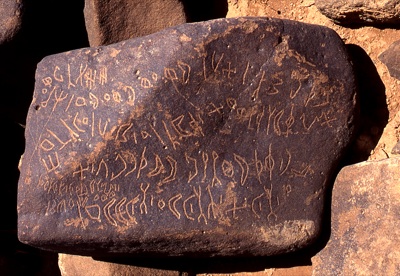
Safaitic is the name given to an alphabet used by tens of thousands of ancient nomads in the deserts of what are now southern Syria, north-eastern Jordan, and northern Saudi Arabia. Occasionally, Safaitic texts are found further afield, in western Iraq, Lebanon, and even at Pompeii. They are thought to have been carved between the first century BC and the fourth century AD, though these limits can be no more than suggestions based on the fact that none of the approximately 35,000 texts known so far seems to mention anything earlier or later than these limits. Safaitic has an alphabet of 28 letters, which are assumed to represent a phonemic repertoire roughly equivalent to that of Arabic. No vowels or diphthongs (if they existed) are represented. The texts can be carved in any direction and there is no division between words. They are all graffiti or grave-markers. There is no indication that the Safaitic alphabet was ever used for writing in ink, which would have encouraged the use of a single direction and word division as aids to the reader. It appears that the nomads who used the ANA scripts lived in oral societies where they had few materials to write on except rocks and thus little use for writing except as a way of passing the time while guarding the flocks or on the look-out for game or enemies, which is exactly what their graffiti say they were doing. Thus, writing was a pastime for them and when they carved their texts they were doing so purely for their own amusement and, since they did not expect anyone to read them, they did nothing to assist a reader.